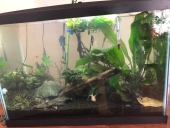


Jay Smithy wrote:Regarding "Rock Wool".
First, unless the package you get it in specifically states that it is something else, it is likely just cheap, course fiberglass insulation type material.
Jay Smithy wrote:
Second, unlike just about any other growning media, depending on grade, when you take plants out of rock wool, you tear the roots up and leave a lot of root matter in the stuff, where it will break down, which is not the wosrt thing I guess, but TERRIBLE if you are transplanting.
Removing plants from almost any other media turns out to be better, cleaner, easier.

Tom Connolly wrote:I will be putting a 70 gallon (230 liter?) aquarium in my living room. I will slowly stock it with juvenille fish and let grow big together - major point us that the initial bioload will be low. I would like to put two shelves over the aquarium and put 4 house plants on each shelf. They will most likely be spider plants and will also start out as clippings. They will all be grown hydroponically, without any soil. I would like to circulate the water from the aquarium into the plants but I dont know how to calculate the balance so that the water is kept clean and the plants have enough nutrients. Any suggestions?